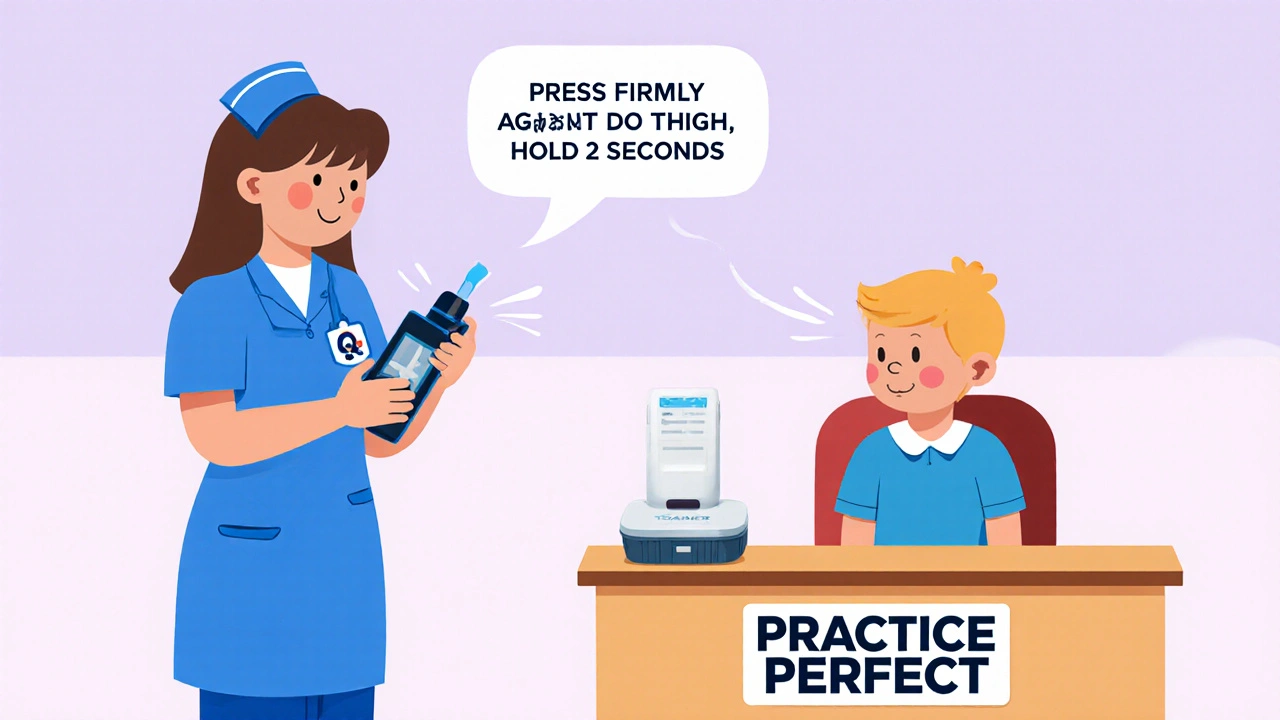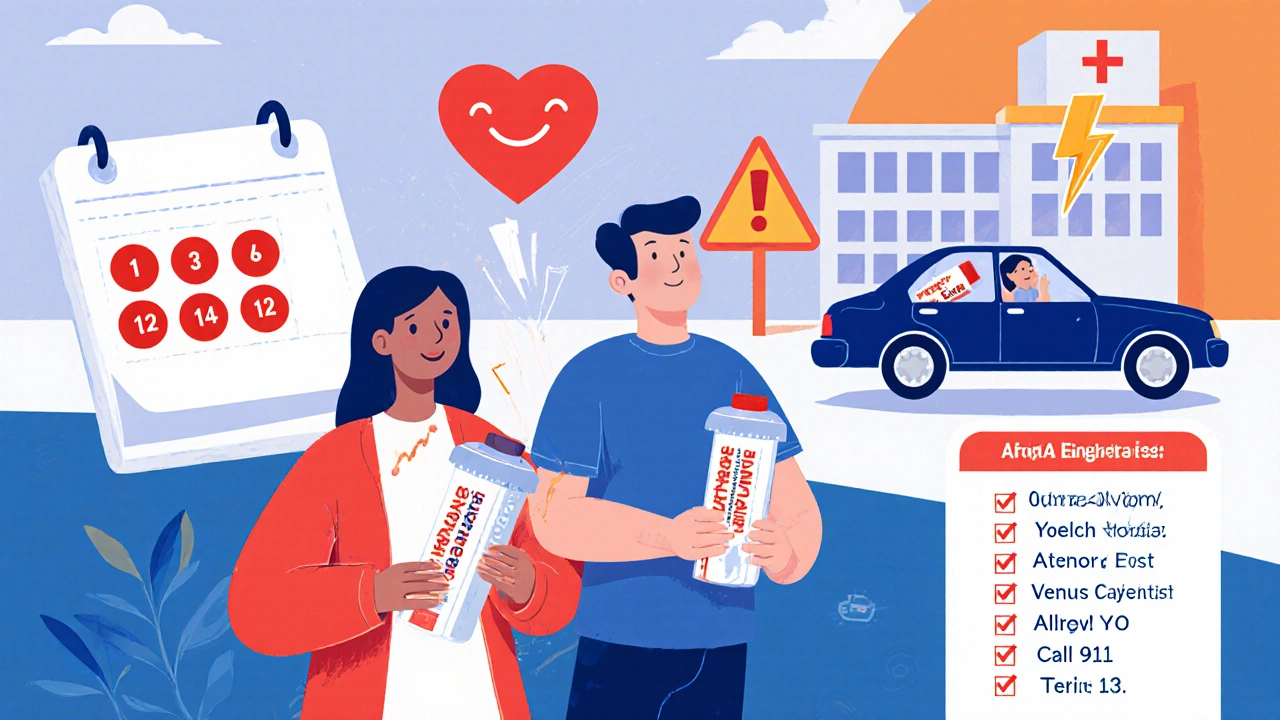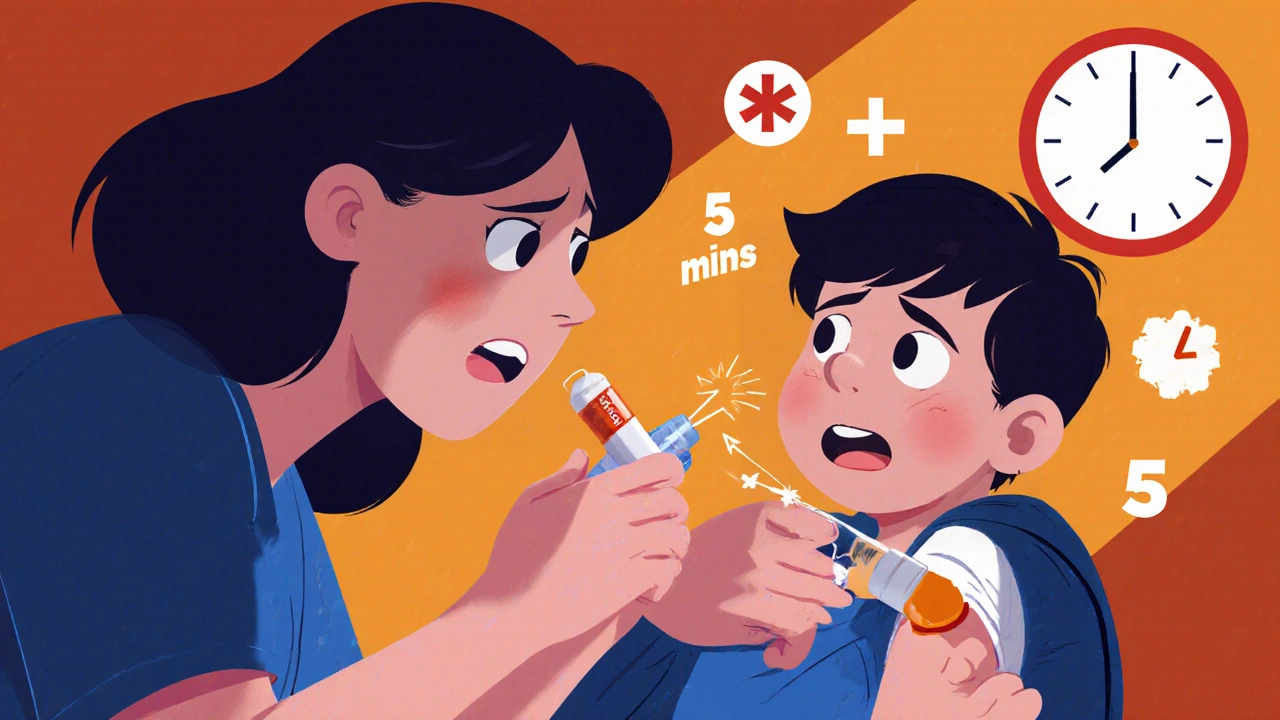When someone is having an anaphylactic reaction, every second counts. The body goes into overdrive-airways swell, blood pressure drops, and breathing becomes impossible. Without quick action, it can turn fatal in minutes. Epinephrine is the only treatment that can stop this process. But if you don’t know how to use the auto-injector correctly, it won’t help. You might hold it too long, miss the thigh, or forget to call 911. And that’s more common than you think. Studies show nearly 60% of people who carry an epinephrine auto-injector don’t use it properly during a real emergency.
What Happens During Anaphylaxis?
Anaphylaxis isn’t just a bad rash or a stuffy nose. It’s a full-body allergic reaction that hits fast. Symptoms can include hives, swelling of the lips or tongue, wheezing, dizziness, vomiting, or a feeling that you’re going to pass out. Your blood pressure plummets. Your airways tighten. Your heart races. The body is shutting down. And antihistamines like Benadryl? They won’t stop it. They might help with mild itching, but they don’t touch the life-threatening parts of the reaction.
Epinephrine works because it’s adrenaline-the same hormone your body releases when you’re scared. It tightens blood vessels to raise pressure, opens up the airways so you can breathe, and calms the immune system’s overreaction. The sooner it’s given, the better. Research shows giving epinephrine within 5 to 15 minutes of symptoms starting cuts the chance of dying by 75%. Delaying it for other meds increases the risk of a second, even deadlier wave of symptoms by 300%.
Which Auto-Injector Do You Have?
Not all epinephrine devices are the same. The most common one is the EpiPen, but there are others: Auvi-Q, Adrenaclick, and the newer Neffy nasal spray. Each works differently.
- EpiPen (0.3mg or 0.15mg): The orange tip pops out when you press it. It’s the most widely used, but also the most prone to user error.
- Auvi-Q: This one talks to you. A voice tells you exactly what to do-“Pull blue safety cap,” “Press firmly against thigh,” “Hold for 2 seconds.” It’s great if you panic.
- Adrenaclick: Cheaper, but you have to remove two caps and manually push a plunger. It takes more steps, which slows you down.
- Neffy: A nasal spray. No needle. But you have to aim it right and breathe normally while spraying. If you sneeze or tilt your head, it won’t work.
Most people in the U.S. use EpiPen. It’s what most doctors prescribe and schools stock. But if cost is an issue, Adrenaclick costs about $200 compared to $700 for EpiPen. Auvi-Q is expensive but has voice guidance. Neffy is new and not yet widely available. Know which one you have. Read the instructions. Practice with a trainer device.
Step-by-Step: How to Use an Epinephrine Auto-Injector
Here’s exactly what to do. No guesswork. No delays.
- Recognize the signs. Swelling of the face or throat? Trouble breathing? Feeling faint? Nausea or vomiting? These are red flags. Don’t wait for a rash. Don’t wait to see if it gets worse. If you suspect anaphylaxis, act now.
- Remove the safety cap. For EpiPen and Auvi-Q, pull the blue safety cap straight off. Don’t twist. Don’t hesitate. For Adrenaclick, remove both the gray and black caps. For Neffy, remove the cap and hold the spray upright.
- Position the injector. Place the tip against the outer thigh. It doesn’t matter if the person is wearing pants. You can inject through clothing. Aim for the middle of the thigh, between the hip and knee. Never inject into the buttocks, hands, feet, or veins.
- Push hard and hold. Press the injector firmly against the thigh until you hear a click (EpiPen) or feel it activate. Hold it there for 3 seconds. For Auvi-Q, the voice will tell you when to stop. For Adrenaclick, push the plunger all the way down and hold for 3 seconds. For Neffy, press one nozzle firmly into each nostril and breathe normally for 10 seconds.
- Remove and massage. Pull the injector away. Rub the injection site for 10 seconds. This helps the medicine absorb faster.
- Call 911 immediately. Even if the person feels better after the shot, they still need emergency care. Symptoms can come back. A second dose might be needed. Emergency teams need to be on the way.
- Be ready for a second dose. If symptoms don’t improve-or get worse-after 5 to 10 minutes, give a second injection. Use the other auto-injector if you have one. Don’t wait. Don’t hope. Give it.

Common Mistakes (And How to Avoid Them)
People make the same errors over and over. Here’s what goes wrong-and how to fix it.
- Not removing the safety cap. 58% of school nurses report this in training drills. Always check: blue cap off? Gray and black caps off? No cap = no shot.
- Injecting in the wrong spot. The thigh is the only place that works. Injecting in the arm, belly, or buttocks delays absorption. The vastus lateralis muscle absorbs epinephrine fastest.
- Not holding long enough. You need 3 full seconds. Most people pull away too soon. The device doesn’t finish delivering the dose. Practice with a trainer.
- Forgetting to call 911. Epinephrine saves lives, but it’s not a cure. The person still needs a hospital. They might need oxygen, IV fluids, or a second dose. Don’t assume they’re fine.
- Using it too early. Epinephrine isn’t for mild hives or sneezing. Use it only when there’s trouble breathing, swelling in the throat, dizziness, or loss of consciousness.
Storage and Expiration
Your auto-injector won’t work if it’s broken by heat or light. Keep it at room temperature-between 59°F and 86°F. Don’t leave it in the car in summer. Don’t put it in the fridge. Don’t freeze it. Keep it in its original case to protect it from sunlight.
Check the expiration date every few months. Most devices last 12 to 18 months. If it’s expired, replace it. If the liquid inside looks cloudy, brown, or has particles, throw it out and get a new one. Even if it’s not expired, if it’s been dropped or exposed to extreme heat, it might not work.
Always carry two. One might fail. One might not be enough. People with known severe allergies should have two at all times-on their person, in their bag, at school, at work. Never rely on just one.

Training and Practice
Reading instructions isn’t enough. You need to practice. Use a trainer device-these look like the real thing but don’t have a needle or medicine. Practice every 6 months. Do it with family members, teachers, coworkers. Make it routine.
Children should practice with their parents. School nurses need training too. In the U.S., only 28 states require school staff to be trained in epinephrine use. That’s not enough. If your child has a food allergy, make sure their teacher knows how to use the injector. Practice with them. Show them the orange tip. Let them press the trainer on a pillow.
Simulation studies show you need about four practice sessions to get it right. Don’t skip this. The difference between a correct injection and a wrong one can be life or death.
What to Do After the Injection
After you give the shot:
- Have the person lie flat on their back. If they’re vomiting or having trouble breathing, turn them on their side. Don’t let them stand or walk.
- Loosen tight clothing. Keep them warm.
- Stay with them. Monitor breathing and pulse.
- Give a second dose if needed, after 5-10 minutes.
- Wait for EMS. Even if they seem fine, they need to be checked in a hospital for at least 4 hours.
Epinephrine wears off in 15 to 30 minutes. Symptoms can return. That’s called a biphasic reaction. That’s why hospitals require observation. Don’t let someone leave just because they feel better.
Why This Matters
Food allergies affect 32 million Americans. One in 13 children has a food allergy. Anaphylaxis is rising. More people are carrying auto-injectors than ever before. But too many people still die because they didn’t use it, or used it wrong.
Epinephrine auto-injectors are simple. They’re designed for anyone to use-even a child. But they only work if you know how. Practice. Know your device. Carry two. Act fast. Don’t wait. Don’t hope. Push the injector. Call 911. Save a life.
Can you use an epinephrine auto-injector through clothing?
Yes. You can inject through pants, jeans, or even thick clothing. The needle is strong enough to pierce fabric. This is especially important in emergencies when removing clothing takes too long. Manufacturers test this with multiple layers of fabric. Always aim for the outer thigh and press firmly.
What if I accidentally inject myself?
If you accidentally inject yourself in the hand or finger, go to the emergency room immediately. Epinephrine in the hand can cut off blood flow and cause tissue damage. This is rare but serious. If you inject yourself in the thigh by accident, it’s less dangerous but still requires medical evaluation. Always call 911 after any accidental injection.
Can children use epinephrine auto-injectors?
Yes. Children as young as toddlers can be trained to use them under supervision. Many schools allow older children to carry their own injector. Use the correct dose-0.15mg for children under 66 pounds, 0.3mg for 66 pounds and over. Practice with a trainer device regularly. Teach them to say “I need my EpiPen” if they feel sick.
Is epinephrine safe if you don’t have an allergy?
Yes. Epinephrine is safe even if given to someone without anaphylaxis. Side effects like a racing heart, shaking, or anxiety are common but short-lived-usually under 30 minutes. The risk of not giving it when needed is far greater. If in doubt, give it. It’s better to give it and be fine than to wait and lose someone.
Do I need to go to the hospital after using epinephrine?
Yes. Always. Epinephrine is a temporary fix. Symptoms can return hours later. A second dose may be needed. Medical staff will monitor your breathing, blood pressure, and oxygen levels. They may give you more medication, IV fluids, or steroids. Never skip the ER after using an auto-injector.
How do I know if my epinephrine injector is still good?
Check the expiration date on the side. Look at the liquid inside-it should be clear and colorless. If it’s brown, cloudy, or has particles, throw it out. If the device was dropped, exposed to heat, or frozen, replace it even if it’s not expired. Always carry two, and replace them before they expire.
Knowing how to use an epinephrine auto-injector isn’t just helpful-it’s essential. It’s the difference between survival and tragedy. Don’t wait for a crisis to learn. Practice now. Be ready. Lives depend on it.


